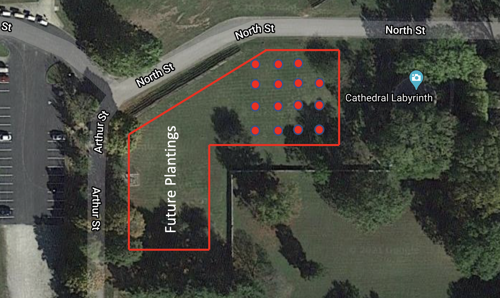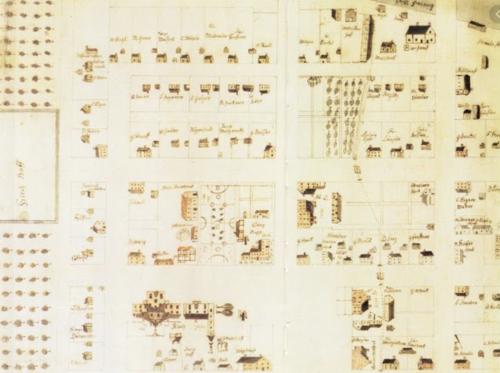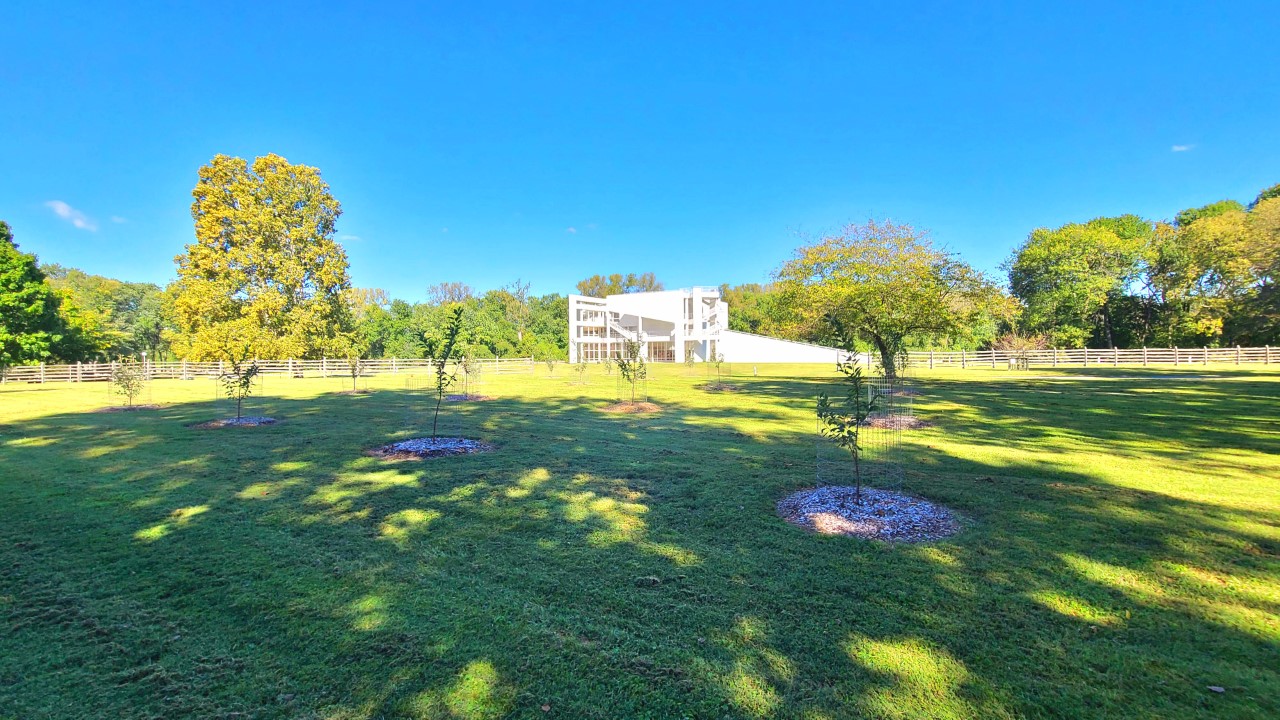The Project to Recognize and Replant
In 2021, Historic New Harmony spearheaded a project to achieve two important goals: replant a key icon of the New Harmony story and recognize and say “thank you” for the generous support of several Southwestern Indiana organizations and entities by Jeremy Efroymson and the Efroymson Family Fund (EFF), who have exceeded $1 million in cumulative giving for the betterment of our area and organizations.
The Harmonist Orchard extended through the Harmonist Cemetery and all the way to the campus of the Atheneum, marked by the large wooden rail fence and as far as South Street. The Harmonist Orchard included not only grape vines, but also fruit producing trees like apple, pear, and sour cherry. For this effort, the land directly across from the Atheneum and lined by North Street and the Harmonist Cemetery was selected and prepared for the replanting, as detailed in the graphic below:

We followed the Harmonist grid and placement detailed in the “Weingartner Map”. The Weingartner Map is a map of New Harmony, Indiana, that was drawn from memory by Wallrath Weingartner in 1832, seven or eight years after the Harmony Society had returned to Pennsylvania. Though other contemporaneous maps exist, it is the only one that depicts the physical appearance and locations of the buildings and orchard in 1824.

For this first phase, fifteen sour cherry trees were planted. Sour cherry trees were chosen because they were used by the Harmonists to produce wine, when mature the blooms will further add to the beauty of the space and New Harmony, and because the long-term maintenance is lower than other fruit trees that the Harmonists planted.
After much research, the variety of sour cherry tree selected was Prunus Cerasus (or Amarelle), a sour cherry from Europe. Not only is this variety "of the period" it was also detailed as being used by Prince Maximilian in his 1832 account while staying in New Harmony.
Entities and Individuals Who Sponsored Trees in Thanks to Jeremy Efroymson and the Efroymson Family Fund
John and Deborah Busch
Harmonie Associates
Historic New Harmony Association of Interpreters
Hoosier Salon/Dr. George and Peggy Rapp
The Lora Arneberg Charitable Fund
Raymond and Barbara McConnell
The National Society of The Colonial Dames of America in the State of Indiana
New Harmony Business Associates
The New Harmony Project
The Kent and Laurie Parker Family Foundation
Kent and Suzy Schuette
St. Stephen's Episcopal Church
The USI Foundation
Connie Weinzapfel
The Working Men's Institute
Additional thanks go out to USI Associate Professor of Anthropology World Languages and Cultures Mike Strezewski, the Indiana State Museum and Historic Sites, the Department of Natural Resources, and local arborist, Tom Guggenheim. Everyone helped craft a thoughtful and respectful approach for this project on this beautiful and historic site.
Please note that this was a community funded project and was not funded by the University of Southern Indiana.
A Brief History of New Harmony's Harmonist Orchard
The western edge of present-day New Harmony is where the Harmonist Orchard was located. The split rail fence indicates the border of the original Harmonist town. The Harmonists did not build or plant any closer to the river due to the Wabash River's flooding. The orchards contained "mostly apple and peach trees, also some pear and cherry trees."
Need more information?
Andrea Gentry, Director of Development, USI Foundation at 812-464-1997 or Claire Eagle, Interim Assistant Director of Historic New Harmony, at 812-682-4488.
